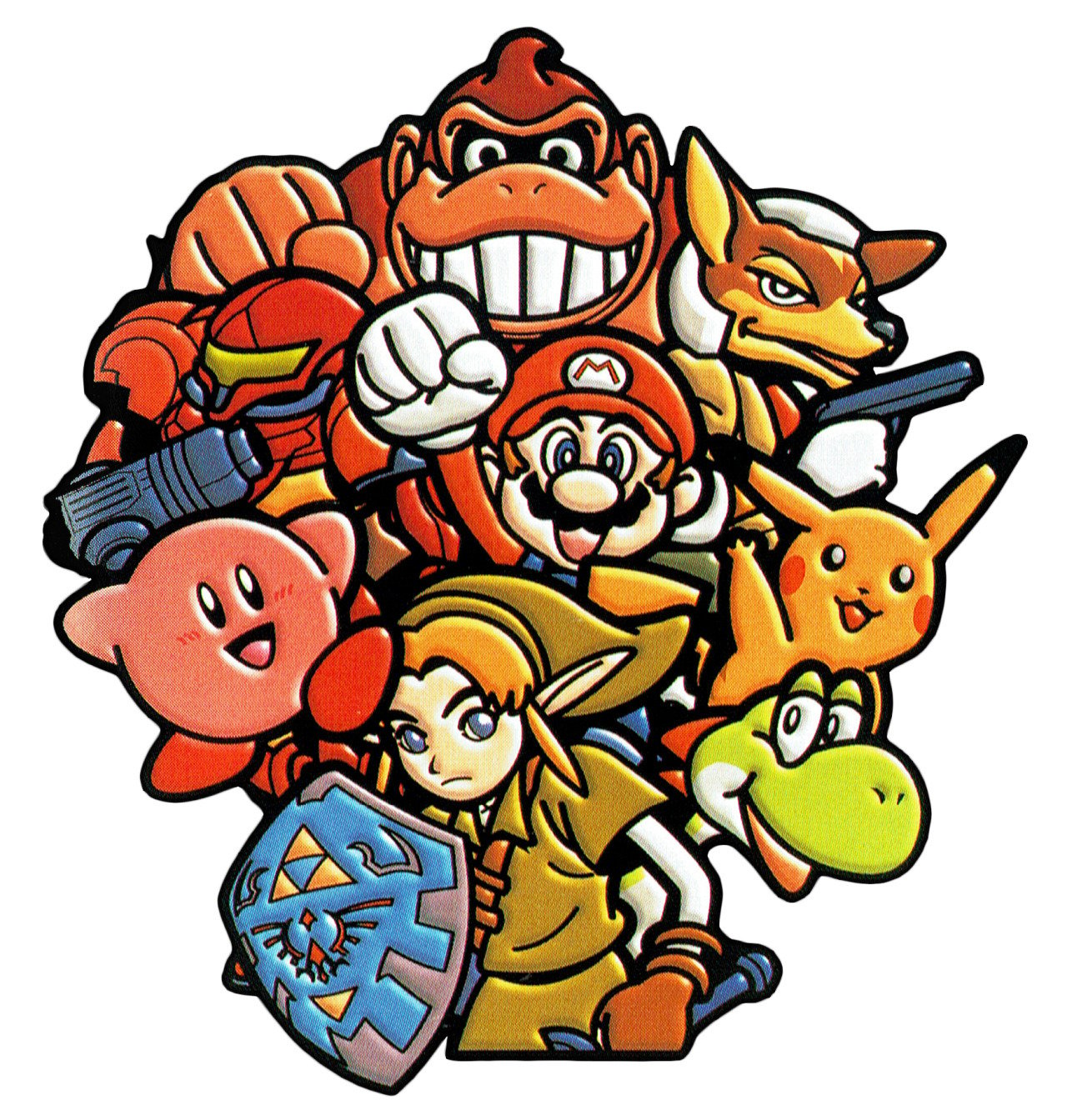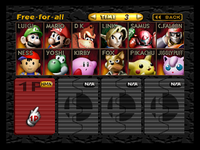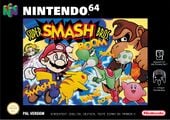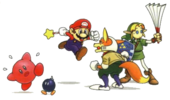Super Smash Bros.
| “ | Something's gone wrong in the happy-go-lucky world of Nintendo! | ” |
| —North American commercial | ||
- For the article about the series, see Super Smash Bros. (series). For the article about the universe, see Super Smash Bros. (universe).
| Super Smash Bros. | |
|---|---|
| Super Smash Bros. North American box | |
| Developer(s) | HAL Laboratory, Inc. |
| Publisher(s) | Nintendo |
| Designer(s) | Masahiro Sakurai |
| Released | Nintendo 64: Virtual Console: |
| Mode(s) | Single-player, multiplayer (2-4) |
| Ratings | ESRB: E PEGI: 7 OFLC: G8+ |
| Platform(s) | Nintendo 64 iQue Player Virtual Console |
| Media | 128 megabit cartridge Flash Card (China) |
Super Smash Bros., known in Japan as Nintendo All-Star! Great Fray Smash Brothers (ニンテンドウオールスター! 大乱闘スマッシュブラザーズ), often shortened to "Smash 64", "SSB", or "SSB64", is the first game of the Super Smash Bros. series. As a relatively low-budget game with an unusual concept, there were not originally any plans to export the game outside Japan. Only the game's unexpected popularity led to its worldwide release. It is the only Super Smash Bros. game to be rated E, as Melee and Brawl are rated T, and Smash 4 is rated E10+, according to the ESRB.
The game was released in Japan on January 21, 1999, in North America on April 26, 1999, and in Europe on November 19, 1999. The game is playable on Nintendo 64 and the iQue Player, and is available on the Wii's Virtual Consoles. The Virtual Console version was released on January 20, 2009 in Japan, one day before the 10-year anniversary of the game, and later released on June 12th 2009 and December 21, 2009 in Europe and North America, respectively.
Opening movie
Every time the opening movie plays, the two characters Master Hand picks who appear fighting on a mountain-top at the beginning of the movie varies. If certain secret characters have not been unlocked yet, they appear as silhouettes.
<youtube>cYvoDkIS7e4</youtube>
Characters
There are twelve playable characters in Super Smash Bros., eight of which are available from the start, and four of which are unlockable.
Playable characters
| Starter characters | |||
|---|---|---|---|
 Mario |
 Donkey Kong |
 Link |
 Samus |
 Yoshi |
 Kirby |
 Fox |
 Pikachu |
| Unlockable characters | |||
 Luigi |
 Captain Falcon |
 Ness |
 Jigglypuff |
Non-playable characters
 Giant Donkey Kong |
 Metal Mario File:MetalMarioSymbol.png |
 Fighting Polygon Team |
 Master Hand |
Planned characters
According to a page on the Japanese Super Smash Bros. site, Mewtwo, Bowser, and King Dedede were all planned to be playable, but were cut, though no other information is available. Bowser would later be playable in Melee, Brawl, and Smash 4, Mewtwo would be playable in Melee and Smash 4, and King Dedede would be playable in Brawl and Smash 4. There have been rumors that other characters were supposed to be included in the game as well, but no official source exists to confirm these rumors.
Stages
Stages
| Stages | ||||
|---|---|---|---|---|
 Peach's Castle |
 Congo Jungle |
 Hyrule Castle |
 Planet Zebes |
 Mushroom Kingdom |
 Yoshi's Island |
 Dream Land |
 Sector Z |
 Saffron City |
|
Shown in bold, Mushroom Kingdom is the only unlockable stage in Super Smash Bros.
1P Game-only stages
| 1P Game-only stages | |||||
|---|---|---|---|---|---|
| File:Mario Target Smash SSB.jpg Break the Targets |
 Board the Platforms |
 Meta Crystal |
 Race to the Finish |
 Battlefield |
 Final Destination |
These stages only appear in the 1P Game.
Non-playable stages
| Non-playable stages | ||
|---|---|---|
 Kirby Beta Stage 1 |
 Kirby Beta Stage 2 |
File:TutorialStage.jpg Tutorial Stage |
These stages cannot be unlocked or played on in any way without hacking.
Modes
1-Player
Multi-player
Tournament play
Unlike its successors, Super Smash Bros. never enjoyed a large professional competitive scene in North America. However, interest in the game has been renewed in recent years with the popularity of Melee and Brawl. Players can play Super Smash Bros. online through Kaillera using the Project64k emulator. Recently, there have been more and more tournaments of Super Smash Bros. due to an influx of new players. Most Super Smash Bros. tournaments are paired up with Melee events and most (offline) SSB tournaments are located in California, Canada, or New Jersey.
The standard tournament rules differ little from that of Melee. The most common standard tournament rules are as follows:
- The required number of victories to win are generally the best of 3 matches; the only exceptions are finals, in which the number of matches are 5 or 7.
- Double eliminations are in place.
- 5 stock with a 10 minute time limit, if it is possible; most emulators don't have time limits.
- Items are turned off.
- Handicaps are off.
- The first match is played on Dream Land.
- Counterpick stages are Congo Jungle and Peach's Castle.
- The loser of each match picks the stage for the next match from the list of counterpick stages or Dream Land
- In some more restrictive rulesets, such as the Japanese ruleset, only Dream Land is legal and every other stage is banned.
- For the first match, characters are chosen double-blind - at the same time, so that neither player knows their opponent's character beforehand.
- Players may re-pick characters after each match. However, the loser of each match gets to pick last (known as slob picks).
Reception
Super Smash Bros. was a commercial success, selling 5 million copies worldwide with 2.93 million sold in the United States and 1.97 million copies sold in Japan. It was the 5th best selling game for the Nintendo 64. Reviews were mostly positive, with many critics praising the game's addictive and fun multiplayer gameplay and simple controls, but it was criticized as well, mainly due to the game's lack of content and somewhat limited single player mode.
Online play
Although Super Smash Bros. does not feature online play, emulators have the ability to do so. Project64k and Mupen64k are the most used emulators of playing online.
Gallery
Commercials
<youtube>K783SDTBKmg</youtube> <youtube>wGx1_V8J_F0</youtube>
Trivia
- Early in development, Super Smash Bros. was called Dragon King: The Fighting Game, and didn't have any Nintendo characters at all. [1]
- The starting eight characters are placed in the order of when they first appeared in their respective titles on the character selection screen, starting with the oldest, Mario and Donkey Kong, and leading to the most recent, Pikachu.
- However, because of the placing of the unlockable characters on the sides of the character selection screen, Luigi gets listed first before Mario and Donkey Kong, despite the fact he debuted 2 years after Mario and Donkey Kong's debuts. The same is true for Ness next to Yoshi, only it is a four-year difference.
- Nevertheless, the four unlockable characters are placed in chronological order of first appearance relative to each other. Luigi (1983), Captain Falcon (1990), Ness (1994), and Jigglypuff (1996) appear in this order left to right, top to bottom, occupying the four corners of the character selection screen.
- However, because of the placing of the unlockable characters on the sides of the character selection screen, Luigi gets listed first before Mario and Donkey Kong, despite the fact he debuted 2 years after Mario and Donkey Kong's debuts. The same is true for Ness next to Yoshi, only it is a four-year difference.
- This is the only time Samus and Ness appeared on the Nintendo 64, and so is also their first appearance in 3D.
- This is the only game to feature playable protagonists only. However, two characters had previously appeared as antagonists -- Donkey Kong in Donkey Kong and Donkey Kong 3 and Mario in Donkey Kong Jr. and Donkey Kong Circus.
- Super Smash Bros. is the only game to use the phrases "Game Set" and "Time Up" in matches in both English and Japanese versions. Melee, Brawl, and Smash 4 use the phrases "Game!" and "Time!" in the English version, while each one still uses "Game Set" and "Time Up" in the Japanese version.
- Samus is the only definite female character in the game, as Pokémon were not considered gendered at the time of this game.
- This is the only game to lack stages from the F-Zero and Earthbound universes.
External links
References
| Super Smash Bros. series | |
|---|---|
| Super Smash Bros. · Super Smash Bros. Melee · Super Smash Bros. Brawl · Super Smash Bros. 4 (for Nintendo 3DS · for Wii U) · Super Smash Bros. Ultimate |




